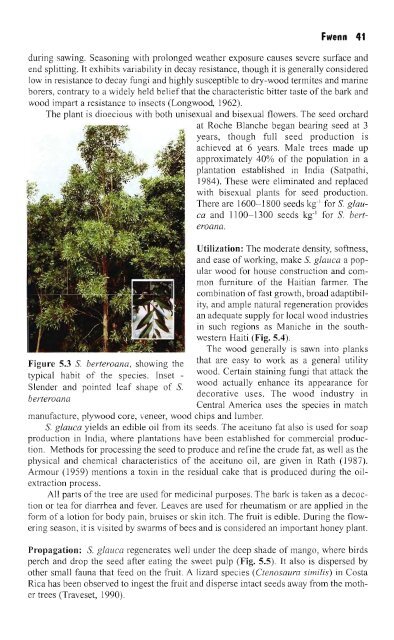Bwa-yo - Société Audubon Haiti
Bwa-yo - Société Audubon Haiti
Bwa-yo - Société Audubon Haiti
Create successful ePaper yourself
Turn your PDF publications into a flip-book with our unique Google optimized e-Paper software.
Figure 5.3 S. berteroana, showing the<br />
typical habit of the species. Inset <br />
Slender and pointed leaf shape of S.<br />
berteroana<br />
Fwenn 41<br />
during sawing. Seasoning with prolonged weather exposure causes severe surface and<br />
end splitting. It exhibits variability in decay resistance, though it is generally considered<br />
low in resistance to decay fungi and highly susceptible to dry-wood termites and marine<br />
borers, contrary to a widely held beliefthat the characteristic bitter taste ofthe bark and<br />
wood impart a resistance to insects (Longwood, 1962).<br />
The plant is dioecious with both unisexual and bisexual flowers. The seed orchard<br />
at Roche Blanche began bearing seed at 3<br />
years, though full seed production is<br />
achieved at 6 years. Male trees made up<br />
approximately 40% of the population in a<br />
plantation established in India (Satpathi,<br />
1984). These were eliminated and replaced<br />
with bisexual plants for seed production.<br />
There are 1600-1800 seeds kg-I for S. glauca<br />
and 1100-1300 seeds kg-I for S. berteroana.<br />
Utilization: The moderate density, softness,<br />
and ease of working, make S. glauca a popular<br />
wood for house construction and common<br />
furniture of the <strong>Haiti</strong>an farmer. The<br />
combination of fast growth, broad adaptibility,<br />
and ample natural regeneration provides<br />
an adequate supply for local wood industries<br />
in such regions as Maniche in the southwestern<br />
<strong>Haiti</strong> (Fig. 5.4).<br />
The wood generally is sawn into planks<br />
that are easy to work as a general utility<br />
wood. Certain staining fungi that attack the<br />
wood actually enhance its appearance for<br />
decorative uses. The wood industry in<br />
Central America uses the species in match<br />
manufacture, plywood core, veneer, wood chips and lumber.<br />
S. glauca yields an edible oil from its seeds. The aceituno fat also is used for soap<br />
production in India, where plantations have been established for commercial production.<br />
Methods for processing the seed to produce and refine the crude fat, as well as the<br />
physical and chemical characteristics of the aceituno oil, are given in Rath (1987).<br />
Armour (1959) mentions a toxin in the residual cake that is produced during the oilextraction<br />
process.<br />
All parts of the tree are used for medicinal purposes. The bark is taken as a decoction<br />
or tea for diarrhea and fever. Leaves are used for rheumatism or are applied in the<br />
form of a lotion for body pain, bruises or skin itch. The fruit is edible. During the flowering<br />
season, it is visited by swarms of bees and is considered an important honey plant.<br />
Propagation: S. glauca regenerates well under the deep shade of mango, where birds<br />
perch and drop the seed after eating the sweet pulp (Fig. 5.5). It also is dispersed by<br />
other small fauna that feed on the fruit. A lizard species (Ctenosaura similis) in Costa<br />
Rica has been observed to ingest the fruit and disperse intact seeds away from the mother<br />
trees (Traveset, 1990).



